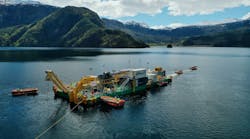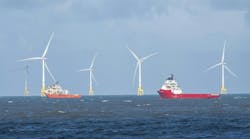The North Sea Link (NSL), a 720 km long interconnector project that will link the Norwegian and British markets and is now being installed in Norwegian waters, is on schedule despite the challenges of the COVID-19 pandemic.
Statnett and British company National Grid is building the NSL interconnector between Norway and the UK.
A unique operation in Lake Suldalsvatnet in Norway marked the beginning of construction from the Norwegian side of the project.
Kirsten Faugstad, project manager for subsea cable in the North Sea Link project, said that the operation on Lake Suldalsvatnet is rather unique, noting that a custom-built cable laying platform measuring 43x15 meters had to be made for the operation. Faugstad said that this is the first time in Norway that this type of operation has been done on such a large scale.
The special platform was built in one week. All the equipment necessary to do the work was installed on the fleet, and within 12 hours, 150 tonnes of cable were loaded on board. Supplier Nexans has manufactured the cable in Halden and is carrying out the work on the Norwegian side on behalf of the NSL project.
NSL consists of two parallel high voltage cables between UK and Norway. When the work is completed in 2021, the total route will be 720 km long. In Suldalsvannet, 2,8 km parallel cables have been placed on up to 200 meters depth.
The construction work continues on the seabed through the fjords from Suldal in the South West of Norway. It is about 100 kilometers from Hylsfjord in Suldal municipality and out through the fjords to the North Sea. In 2021, another 144 km will be added, until the British and Norwegian sides connect. The Italian company Prysmian is doing the work on the British side and started installing the cable in 2018. By 2021 they will have added 2/3 of the route from England to the point where Nexans takes over.
When the winds blow in the UK and wind power production is high, Norway will be able to import power from the British to a lower price than in the Norwegian market and conserve the water in Norway's many hydropower reservoirs. When there is little wind and a greater need for power in the UK, the situation will be the other way around. UK then can import Norwegian hydropower to a lower price than in the British market and through this secure the power supply.
Linking Nordic and British energy markets will bring a number of benefits, including increased security of supply because one can import more electricity at a lower price when the power situation is tight; increased market for power producers when there is a surplus of power in the national market; facilitation of higher production and consumption of renewable energy in Norway and the UK, thereby contributing to future climate-friendly energy; and ore predictable supply situation and price throughout the year and from year to year.
Statnett

Voice your opinion!
Voice your opinion!
To join the conversation, and become an exclusive member of T&D World, create an account today!
Latest from Undersea Applications
Latest from Undersea Applications

